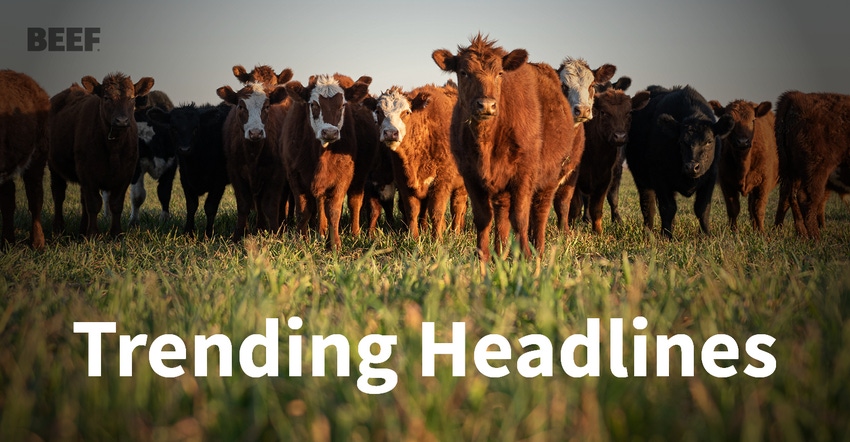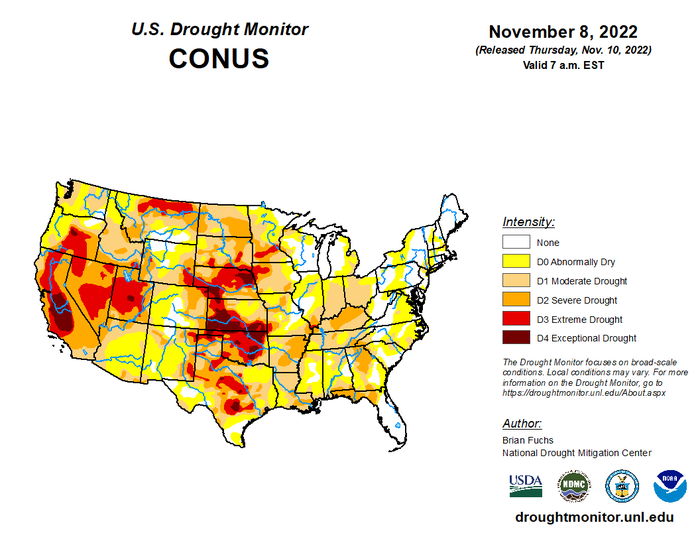5 Trending headlines in beef 2
Let’s examine some of the headlines facing cattle producers this week.

In this week’s roundup, we take a look at drought conditions, a prediction of the cattle market for next year and a bull with a mind of his own.
The latest U.S. drought monitor doesn’t show much improvement. In fact, dry conditions are growing in the Midwest. The one area that showed the most improvement was Arkansas with the drought being reduced from extreme drought conditions to severe drought conditions.

2. An agriculture economist from Texas A&M Department of Agriculture Economics says consumers can expect more drought conditions and higher beef prices in 2023.
Drought conditions that loomed over a large portion of the U.S. earlier this year will continue to threaten the nation's agriculture industry into 2023 as experts forecast a continued drop in cattle supply, which could consequently drive prices to a record-high within the next two years. Extreme temperatures and long-lasting heatwaves have also resulted in the biggest cattle slaughter in a decade, accounting for about 80,000 head of cattle per week as it became increasingly difficult to provide the feed and water necessary to sustain the animals.
“Drought affects all aspects of the cattle business," said David Anderson, AgriLife Extension economist in the Texas A&M Department of Agricultural Economics. "The reason we have culled so many cows this year is because of drought and the cost of corn. High corn prices will lead to a high feed cost environment into next year. Production costs have also increased faster than calf prices.”
Regional drought woes
Historically, Texas is one of the most prominent suppliers of the U.S. beef cattle herd, and cattle ranchers were no stranger to the woes of drought from earlier this year.
The Abilene Reporter-News reported in mid-July that several auction houses in the region were already inundated with cattle ranchers looking to cull their herd by July 4 weekend.
According to the U.S. Department of Agriculture, the nation's beef cow herd — just over 30 million head — was already down 2% compared to last year going into the year, and the estimated inventory for Texas cattle was 5.1 million head, down 3% from 2020.
Earlier this year, Anderson noted that, as in the case of the similarly decimating 2011 drought, the market may see the greatest impact next year in terms of prices.
"The beef cattle market isn’t something that turns on a dime,” Anderson said in July. “It takes time. Cattle are a long-term cycle, and I suspect this will all play out similarly to the years following the 2011 drought.”
Anderson said he anticipates cattle prices will see a record-high — of up to $2 a pound for 550-weight calves — within the next two years according to the AgriLife Extension office.
Harvest is wrapping up for most producers across the area. Sproducers are busy baling crop residue for livestock feed or bedding.
Others may have already planted a cover crop to help prevent wind or water erosion. Many producers will be moving cattle out onto corn and soybean stubble to graze over the winter months.
While lots of producers in this area of Nebraska have cattle, some do not, which makes it difficult to incorporate the benefits of grazing into your operation.
UNL’s Crop Residue Exchange website allows producers with land to connect with producers who have cattle. Row-crop producers can create an account and list available cropland on an interactive map and enter information about their ground, including type of residue, fencing, water availability, and how long they would be willing to have cattle graze.
Cattle producers can also create an account and connect with row-crop producers who would be interested in having their fields grazed. Sometimes landowners may only list one site but have several pivots or sections available for grazing. Reach out to interested landowners listed on the website to see what kind of agreement can be reached.
One question I have received over the past couple weeks is how much a landowner should charge to a cattle producer to graze their stalks. The answer is never simple because a lot of it comes down to preference and what mutual agreement can be reached.
Some questions to consider when negotiating a rental price includes are we charging per day or per acre? Who provides water or fencing? How much work will each party put into this agreement?
It’s understandable that landowners may ask for more rent due to increased input costs. However, if the tenant is doing all the work, make sure to consider that when negotiating an equitable price.
Your local Extension Office may have local cash rental rates to help the decision-making process, but it might also be helpful to talk to your local ag lender to see what they think is equitable, too.
Ultimately, the exact price will have to be negotiated for each unique situation and landlord-tenant. When agreeing on a price, make sure to get it in writing including responsibilities for each party and beginning/ending dates for grazing so there’s no question when spring field prep gets underway.
4. A veterinarian is sounding the alarm when it comes to foot and mouth disease.
Foot-and-mouth disease, potentially one of the most worrisome contagious cattle diseases, is a disease that primarily affects animals with cloven hooves like cattle, sheep, and goats. Its impact is huge, with the potential to cause over $130 billion in losses in the U.S. cattle markets over a 10-year span, based on some estimates.
But the person responsible for determining if an animal has FMD may not be able to tell from inspection alone, said DVM Laura Bledsoe.
In a presentation at a cattlemen’s convention in August, Bledsoe showed photos of animals infected with FMD and compared them with the mouth and hoof sores from other conditions that can mimic FMD.
“Can you tell the difference? Because I can’t,” she said. “There are many other conditions that look like FMD, but we are asked to make the determination if it is FMD or not in the field.” According to the USDA Animal and Plant Health Inspection Service, animals with FMD typically have a fever and blisters on the tongue and lips, in and around the mouth, on the mammary glands, and around the hooves. The agency’s information explains how these blisters, called “vesicles,” pop and turn into red areas called “erosions.” Pain and discomfort from the vesicles and erosions lead to other signs of illness such as depression, anorexia, excessive salivation, lameness, and reluctance to move or stand. Most affected animals will not die from FMD, the APHIS website notes, but the disease leaves them weakened and unable to produce meat and milk the way they did before becoming sick. Because FMD can be so difficult to distinguish, Dr. Bledsoe said the focus for preventing the disease needs to be re-examined. “Right now our disease containment and prevention is based on early detection and traceability, but because it can be hard to tell if it’s FMD, we should be looking towards the contaminants first,” she noted. FMD, not currently present in the U.S., is present in other countries that export goods to the U.S., including the United Kingdom and Uruguay. It is in these items, including feedstuffs, that FMD can be present for months. Solutions for eradicating an FMD outbreak after it is present are not easy.
“We have three options: stamping out with depopulation, stamping out with mandatory vaccination, and stamping out with emergency vaccinations,” she said. “We can prioritize a return to FMD-free status or prioritize keeping affected animals alive, but not both.” Other countries offer a cautionary tale about how difficult the disease can be to control.
5. And last--but not least, a bull is causing havoc along the Kentucky/West Virginia border.
Last month, a semi carrying cattle was stalled in traffic in Louisville, Kentucky, and was hit by a UPS truck. The crash caused 11 cattle to escape, with some of them roaming in Cherokee Park. Seven of them were found while three of the four were captured by West Virginia wranglers in the area of Baxter Avenue in the Highlands.
After more than a three-week search, the lone missing bull has been located, but it will take a local wrangler to catch him.
The bull remains on the loose and many in the area say a good wrangler is needed to capture him.
About the Author(s)
You May Also Like


.png?width=300&auto=webp&quality=80&disable=upscale)
